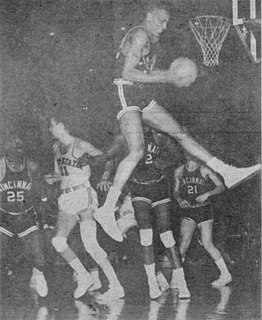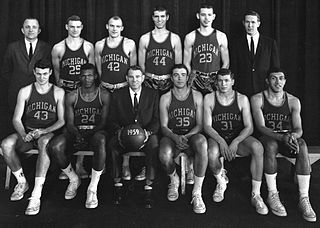
Harold Everett Greer was an American professional basketball player. He played for the Syracuse Nationals / Philadelphia 76ers of the National Basketball Association (NBA) from 1958 through 1973. A guard, Greer was a 10-time NBA All-Star and was named to the All-NBA Second Team seven times. He was named to the NBA's 50th Anniversary All-Time Team, the NBA 75th Anniversary Team, and he had his uniform number retired by the 76ers. Greer is a member of the Basketball Hall of Fame.

Franklin Delano Selvy is an American former National Basketball Association (NBA) player who is best known for holding the record for the most points (100) in a Division I college basketball game. Born in Corbin, Kentucky, Selvy was an All-State basketball player at Corbin High School and was a teammate of College Football Hall of Fame inductee Roy Kidd. Selvy was the No. 1 overall pick in the 1954 NBA draft and was a two-time NBA All-Star, playing nine seasons.

Ronald John Kramer was a multi-sport college athlete and professional American football player.

Terry Gilbert Dischinger is an American former basketball player in the National Basketball Association (NBA). Dischinger was a three-time NBA All-Star and the 1963 NBA Rookie of the Year, after averaging 28 points per game in his three seasons at Purdue University.

Christian Steinmetz was an American basketball player. He played forward for the University of Wisconsin from 1903 to 1905. He was college basketball's leading scorer in the game's first 25 years from 1895 to 1920. He became known as the "Father of Wisconsin Basketball" and was inducted into the Naismith Memorial Basketball Hall of Fame in 1961.

Bill "The Hill" McGill was an American basketball player best known for inventing the jump hook. McGill was the No. 1 overall pick of the 1962 NBA draft from the University of Utah, after leading the NCAA in scoring with 38.8 points per game in 1961–1962.

George Wilson is a retired American professional basketball player.
Duane W. "Skip" Thoren is an American former professional basketball player. At a height of 6 ft 10 in tall, he played at the center position.

The 1958–59 Michigan Wolverines men's basketball team represented the University of Michigan in intercollegiate college basketball during the 1958–59 season. The team played its home games at Fielding H. Yost Field House on the school's campus in Ann Arbor, Michigan. Under the direction of head coach William Perigo, the team finished tied for second in the Big Ten Conference but failed to get an invitation to either the 1959 NCAA Men's Division I Basketball Tournament or the 1959 National Invitation Tournament. During the season, the team beat two of the four ranked opponents that it faced. M.C. Burton, Jr. won the Big Ten Conference statistical championships for both scoring and rebounding. The 17.8 rebounds per game was a Big Ten Conference record that lasted one season. Burton was the first player to lead the conference in both scoring and rebounding. Burton and George Lee served as team co-captains, and Burton earned team MVP.

The 1960–61 Michigan Wolverines men's basketball team represented the University of Michigan in intercollegiate college basketball during the 1960–61 season. The team played its home games at Fielding H. Yost Field House on the school's campus in Ann Arbor, Michigan.
The 1956–57 Michigan Wolverines men's basketball team represented the University of Michigan in intercollegiate college basketball during the 1956–57 NCAA University Division men's basketball season. The team played its home games at Fielding H. Yost Field House on the school's campus in Ann Arbor, Michigan. Under the direction of head coach William Perigo, the team finished tied for fifth in the Big Ten Conference.

The 1937–38 Michigan Wolverines men's basketball team represented the University of Michigan in intercollegiate basketball during the 1937–38 season. The team scored 740 points in 20 games for an average of 37.0 points per game—the second highest point total and scoring per game in school history. Despite prolific scoring for the era, Michigan finished in a tie for fifth in the Big Ten Conference. The team compiled a 9–1 record in the first half of the season, including a six-game winning streak at the start of the season. However, the team went 3–7 in the second half of the season for a season record of 12–8, and 6–6 against Big Ten opponents.

The 1936–37 Michigan Wolverines men's basketball team represented the University of Michigan in intercollegiate basketball during the 1936–37 season. The team compiled a 16–4 record, and 9–3 against Big Ten Conference opponents. The team scored 741 points in 20 games for an average of 37.1 points per game – the highest point total and scoring per game in school history up to that time. Michigan finished in third place in the Big Ten.
Peter Sage Tillotson was an American former basketball player. He grew up in Ludington, Michigan, and played basketball for Ludington High School from 1951 to 1954 and the University of Michigan from 1955 to 1958.

The 1959–60 Michigan Wolverines men's basketball team represented the University of Michigan in intercollegiate basketball during the 1959–60 season. The team finished the season in tenth place in the Big Ten Conference with an overall record of 4–20 and 1–10 against conference opponents.
The 1957–58 Michigan Wolverines men's basketball team represented the University of Michigan in intercollegiate basketball during the 1957–58 season. The team finished the season in seventh place in the Big Ten Conference with an overall record of 11–11 and 6–8 against conference opponents.

The 1955–56 Michigan Wolverines men's basketball team represented the University of Michigan in intercollegiate basketball during the 1955–56 season. The team finished the season in a tie for eighth place in the Big Ten Conference with an overall record of 9–13 and 4–10 against conference opponents.

Thomas A. "Tom" Jorgensen, Jr., sometimes known as Jorgy, was an American former basketball coach and player. He was the head coach of the Northern Illinois Huskies men's basketball from 1966 to 1973, compiling a record of 95–61 (.609). He played college basketball at the University of Michigan from 1953 to 1956. He was also an assistant basketball coach at Michigan from 1960 to 1966.
The 1951–52 Michigan Wolverines men's basketball team represented the University of Michigan in intercollegiate basketball during the 1951–52 season. In their fourth season under head coach Ernie McCoy, the Wolverines team compiled a 7–15 record and finished in a tie for eighth place in the Big Ten Conference. Senior Jim Skala was the team captain, leading scorer and Most Valuable Player. The team was notable as the first racially integrated Michigan basketball team with Don Eaddy and John Codwell becoming the first two African-American players.
Govoner Vaughn was a former high school, college and professional basketball player during the 1950s & 60s. Vaughn led Edwardsville High School to a fourth-place finish in the I.H.S.A. 1954 high school playoffs, as well as a second-place finish in 1956 to defending champion, Rockford West. Vaughn played in eight career state playoff games over two seasons, and his 92 points were all scored during the 1956 tournament. He, along with his teammate, Mannie Jackson, were named first-team all-tournament.














